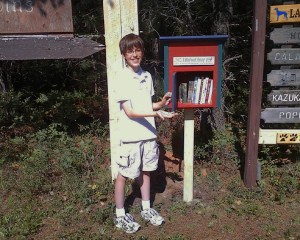Just over 25 miles south of Michigan’s Upper Peninsula sits a library in Arbor Vitae. Drive 10 miles past the small town’s last stoplight, turn left and continue for three miles, then turn right onto a dead-end gravel road surrounded by massive trees. There it is – a little red house with yellow window panes and a blue roof, offering this simple message: “Take a book, return a book.” This small library, however, holds something far greater than its size – the promise for community involvement and literacy.
 The idea for Little Free Library began in Wisconsin in 2009, when co-founder Todd Bol crafted a library to model a red, one-room schoolhouse in memory of his mother, a former schoolteacher and avid reader. Bol filled this new library with books, attached a sign that read “free books” and mounted it in his front yard in Hudson.
The idea for Little Free Library began in Wisconsin in 2009, when co-founder Todd Bol crafted a library to model a red, one-room schoolhouse in memory of his mother, a former schoolteacher and avid reader. Bol filled this new library with books, attached a sign that read “free books” and mounted it in his front yard in Hudson.
Soon, Bol’s friends and neighbors flocked to the library to see what was housed inside. When visitors started asking where they could get their own libraries, Bol built several more and gave them away.
Entrepreneur Rick Brooks of Madison first met Bol while teaching a workshop on green business practices in Hudson. Soon after, Brooks and Bol started working together to create a project that combined their passions for promoting community involvement and literacy. It immediately became clear to them that their idea for Little Free Library was unique and had potential to succeed.
According to ProLiteracy, nearly 30 percent of the U.S. population cannot read above an eighth-grade level, and not having access to books greatly affects this inequality.
“There are lots of reasons that that’s happening, and there are a lot of things we can do about it,” Brooks says. “Reading is part of it. Helping each other is another part of it. Promoting the sense that community and social support are important, that’s part of it. So all of these things fit into what Little Free Library is about.”
People love to know that they are making a difference in their communities, Brooks says, and giving away a book to a friend or neighbor is an easy way to do just that.
By the summer of 2010, construction of a second Little Free Library began in Madison. Throughout 2011, the libraries received local, regional and national media attention, as this simple idea grew into a national social movement. By the end of that year, over 400 Little Free Libraries were offering new titles to book lovers across the country.
According to the organization’s website, American industrialist Andrew Carnegie set out to build 2,509 free public libraries by the end of the 19th surpassed this goal by August 2012. Today, there are over 10,000 registered Little Free Libraries in 55 countries throughout the world.
As Little Free Library grew in popularity, the biggest promoters of the organization were often the library stewards themselves. Jillayne Waite and her 11-year-old grandson Zachary Kane are the stewards of the red, yellow and blue painted Little Free Library in Arbor Vitae. They built their library to “honor those who like to get lost in the adventure of reading,” the organization’s website says.
Waite says she first heard of Little Free Library while listening to a feature story about the organization on the radio during the hour-and-a-half drive from Wausau to her home in Arbor Vitae.
“[Todd Bol], one of the founders, was being interviewed, and it just sounded like such a neat program,” Waite says.
The next day, Waite went on the Little Free Library website to find out more about the organization and learn how to get her family involved in creating a library. Waite, who lives in a three-generation home with her husband, daughter, son-in-law and grandson, says the whole family helped design and construct their own little library.
Using the basic design on the Little Free Library website, Waite’s family began building and painting their library over Memorial Day weekend 2012. But once it was built and filled with books, the family wondered if anyone would ever visit their secluded little library.
Waite says she doesn’t think any of the seven families that live on their road full time know who put the library up. However, that doesn’t stop her neighbors and friends from regularly visiting the library to peruse the books and maybe donate a few of their own, she says.
“The most interesting thing that’s happening is that in the wintertime, we see snowmobile tracks … and footprints going to the library. We just chuckle at that,” Waite says. “It’s fun, it’s a mystery, it’s like opening a present every time we open the door!” In the last year, Waite says she’s read over 50 books that people have shared through her Little Free Library.
Lewis Bosworth, a steward from Madison, used Little Free Library’s online store to purchase a standard model library constructed by a woodworker instead of making his own. The organization’s website offers a variety of library designs at prices ranging from $160 to $630. Bosworth, who is living with a disability, enlisted the help of a friend to install the library in his front yard in November 2012.
“I wanted to give away books, given the sense it’s a Little Free Library, to people who might not otherwise have them, or give them books they might not ordinarily buy,” Bosworth says.
Bosworth, a former UW-Madison lecturer of linguistics and French, believes Little Free Library became so successful throughout Wisconsin because people take pride in their state and the accomplishments of its residents.
“People are proud of things like the Little Free Library because they’re part of Wisconsin; it’s part of our culture,” he says.
 As co-president of the Hidden Valley Reading Council in Platteville, Lindsay Hollingsworth helped establish Little Free Library as the council’s service project to promote community literacy. This volunteer-driven council of reading professionals constructed the library, mounted it in a town garden and named Hollingsworth as steward shortly after first hearing about the idea.
As co-president of the Hidden Valley Reading Council in Platteville, Lindsay Hollingsworth helped establish Little Free Library as the council’s service project to promote community literacy. This volunteer-driven council of reading professionals constructed the library, mounted it in a town garden and named Hollingsworth as steward shortly after first hearing about the idea.
Hollingsworth says becoming the steward for this Little Free Library has not only influenced her community, but her family as well.
“My children love to have ownership [of the library],” she says, “especially since their grandpa built it. They’re very proud.”
By helping maintain the Little Free Library, Hollingsworth’s two children, ages 4 and 7, have quickly learned that being a part of a community requires spending time, effort and creative energy to make their hometown a better place for all its residents.
Although Hollingsworth owns and uses an e-reader, she still believes there is something special that comes with curling up with a book lent by a friend.
“[People] get excited about having good titles and books right at their fingertips,” she says.
Hollingsworth says she and her family often stop to take pictures of the Little Free Libraries they notice while traveling throughout the state.
“It’s a quirky little thing for me,” she says. “It almost becomes like it’s on your radar to keep your eyes out for them. I know it is for me and my family; we just have fun spotting them.”
Just outside the back door of Central United Methodist Church lies one of Milwaukee’s more than 50 Little Free Libraries. Designed to look like a safe to “unlock knowledge,” the library is regularly used by both the church’s parish and visitors to the International Learning Center, an agency within the Neighborhood House of Milwaukee that specializes in literacy and communication education for refugees and immigrants.
Anna Bierer, the library’s steward and director of programs at Neighborhood House of Milwaukee, says she wanted to bring a Little Free Library to the International Learning Center to give Milwaukee residents and visitors access to literature and add to the other community initiatives taking place within the city.
“It takes the idea of sharing and puts it out to the community,” Bierer says. “I love that [Little Free Library] takes books and puts them outside where people can see them.”
Bierer finds it rewarding to promote the work and plans of another Wisconsin nonprofit organization by bringing a Little Free Library to the International Learning Center.
The future of Little Free Library looks promising as the organization continues to promote literacy and community involvement around the world. Brooks says he already sees many new ideas and projects developing from Little Free Library’s original mission.
According to Brooks, the organization has already hosted several design competitions for architects, artists and woodworkers who are creating custom libraries that rival works of art. Brooks believes these annual competitions will continue and grow as more little libraries are constructed each year.
Little Free Library’s idea of “Take a book, return a book” will likely change to include the exchange of other goods, Brooks says.
“This movement will keep going around the world,” he says. “It may move away from a box of books to a box of other things for people with shared common interests.”
Brooks says that Little Free Library has also become a means for authors and book publishers to share their books with readers. In a recent effort to promote reading as a fun, family activity, General Mills donated 20,000 children’s picture books to Little Free Library.
 Additionally, the organization has started measuring how many people visit each registered Little Free Library and how the shared books travel throughout the U.S. and rest of the world. Through this effort, Brooks hopes to study the impact of Little Free Libraries on social capital, reading abilities of children and community engagement.
Additionally, the organization has started measuring how many people visit each registered Little Free Library and how the shared books travel throughout the U.S. and rest of the world. Through this effort, Brooks hopes to study the impact of Little Free Libraries on social capital, reading abilities of children and community engagement.
“The books [in the Little Free Libraries] themselves are wonderful, but they’re the currency through which meaning and value are exchanged,” Brooks says.
People enjoy being generous and selfless because it makes them happy, Brooks says. Furthermore, people want to leave a little something of their life behind after they’re gone, and Little Free Library will continue to serve this special purpose for years.
Check out Little Free Library: Then and Now for more information on the history and Little Free Library Top Five Designs for our favorite libraries.




